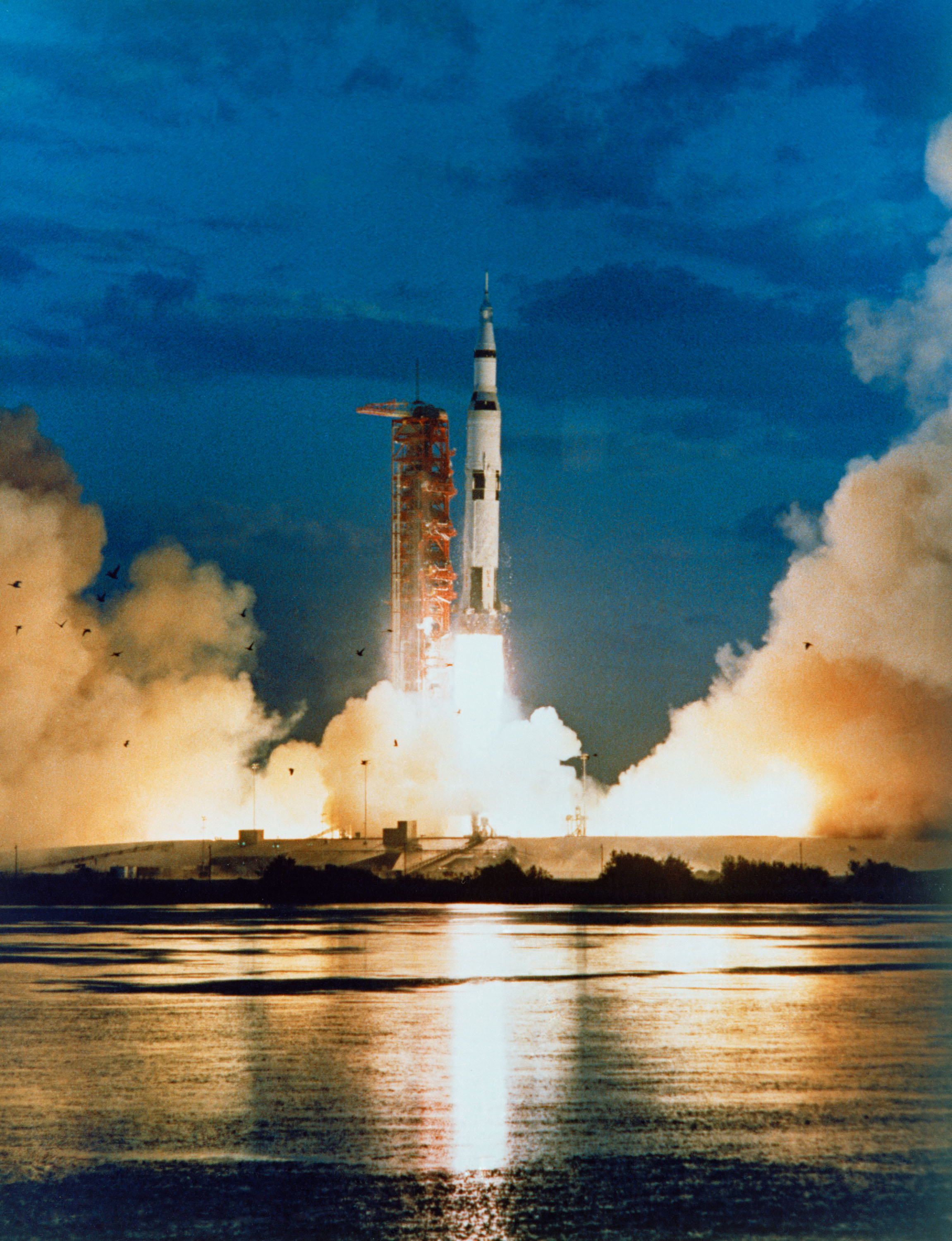
“T-minus-25…,” came the calm, measured tones of the launch announcer in the pre-dawn darkness of Thursday, 9 November 1967. “Stages reporting Ready for Launch…”
Fifty years ago, the largest and most powerful rocket ever brought to operational status thundered into the clear Florida sky, shaking windows, dislodging roof-tiles and making spectators wonder if the Sunshine State had sunk into the ground. Standing 363 feet (110.6 meters) tall, the Saturn V would fly 13 times between 9 November 1967 and 14 May 1973, supporting three unmanned missions, testing the entire Apollo spacecraft in manned capacity in low-Earth orbit and despatching nine crews of human explorers towards the Moon. Although the Soviet Union’s ill-fated N-1 booster had a greater thrust at liftoff, the Saturn V has retained its admirable record for raw, naked power for a half-century. It is a record unlikely to be broken until the Space Launch System (SLS) and other super-heavylift boosters enter operational status, later this decade and into the 2020s.
“…Twelve, eleven, ten…”
From a height, weight and payload-to-orbit standpoint, the Saturn V far surpasses any other operational rocket in history. It evolved from a series of heavylifting launch vehicles, originally identified as “Saturn C-1” through “Saturn C-5”, of which NASA declared its intent to build the latter in January 1962. The rocket would comprise three stages, with five F-1 engines at on the S-IC first stage, five J-2 engines on the S-II second stage and a single J-2 on the S-IVB third stage. In terms of capability, it could deliver up to 310,000 pounds (140,000 kg) into low-Earth orbit or up to 107,100 pounds (48,600 kg) towards the Moon. Early in 1963, the C-5 was renamed “Saturn V”.
Video Credit: NASA
On its first voyage, with the unmanned Apollo 4 Command and Service Module (CSM) at its tip, the booster would be charged with supporting over 4,000 in-flight measurements, two-thirds of which were devoted to the Saturn V itself. The launch had been postponed repeatedly. Originally targeted for late in 1966, S-II development and delivery delays pushed that date to the right, initially to April and eventually May 1967. In the meantime, the processing of other Saturn V elements ran with greater smoothness. The S-IVB arrived at the Cape in August 1966, followed by the S-IC in mid-September, and the Apollo CSM was mounted atop the third stage on 12 January 1967. Finally, on the 21st, the S-II arrived in Florida and was put through an intensive program of inspections and tests.
During this period, astronauts Virgil “Gus” Grissom, Ed White and Roger Chaffee were killed when a flash-fire swept through their spacecraft, during an unfueled test atop a Saturn IB booster on Pad 34 at the Cape. The enforced delay allowed for more detailed inspections of the spacecraft which would ride the first Saturn V. Engineers set to work addressing electrical wiring issues, but by March these proved so numbersome, with more than 1,400 discrepancies, that efforts quickly halted. Not until mid-June was the CSM for the mission—by now redesignated “Apollo 4”—in a position to be restacked atop the S-IVB.
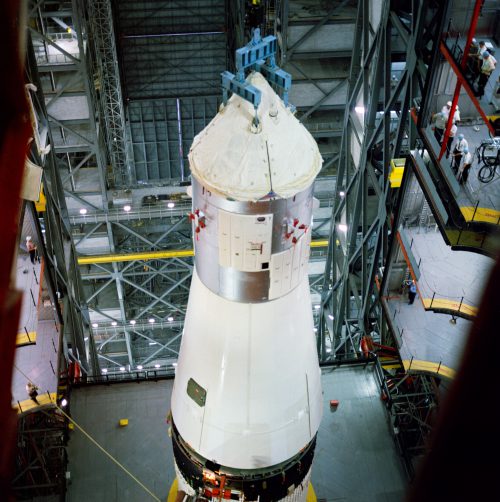
Stacking of the stages was a complex affair, with incredibly close tolerances, as noted by Stanley Smith, Bendix senior engineer for the crane and hoist group. Under his direction, the crane maneuvering the Saturn V components was manned by an operator and an electrician, whilst a third man helped guide movements from floor level, via a walkie-talkie. “We strive to train our men,” Smith said later, “to the point where they could conceivably lower the crane-hook on top of an egg, without breaking the shell!” Following alignment, a crew of engineers, mechanics and quality control inspectors took eight hours mating the pieces of the gargantuan booster together.
Even as progress moved forward, there remained obstacles. Hairline cracks were found in late May in the propellant tank weld seams on another S-II, still in the factory, which necessitated additional checks of the Apollo 4 hardware. A week’s delay to the schedule was expected at most and by 20 June the entire stack had been assembled in the Vehicle Assembly Building (VAB). Nine weeks later, on 26 August 1967, atop the Mobile Launch Platform (MLP), the first flight-ready Saturn V rumbled out of the VAB and out to Pad 39A.
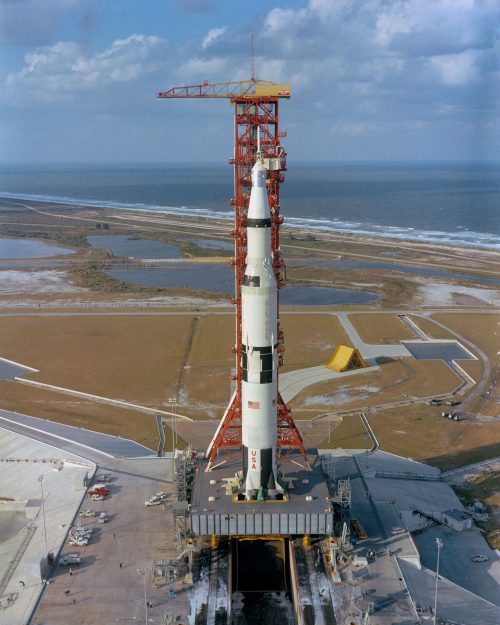
A delayed countdown demonstration test for Apollo 4 got underway in late September. Intended to last six days, it was plagued by difficulties and fell behind schedule from the outset. Computer failures, a faulty regulator on the helium gas system, an exhausted launch operations team and a problematic battery heater conspired against the test, which eventually concluded on 13 October. One observer remarked that the delays had provided the team with “an education that money couldn’t buy”.
The launch date for Apollo 4 was tentatively targeted for 7 November, though few at the Cape expected to meet such a tight deadline. Teams initiated the 56.5-hour countdown late on the 6th, heading for T-0 and liftoff at 7 a.m. EST on the 9th. During this period, 89 truckloads of liquid oxygen, 28 trailer loads of liquid hydrogen and 27 railcars of kerosene were pumped aboard the rocket. By the pre-dawn hours of launch morning, cars jammed the Cape’s access roads, filling all available areas. And by 6:59 a.m., as the first glimmers of daybreak crept across the Florida sky, the ethereal silence was about to be shattered.
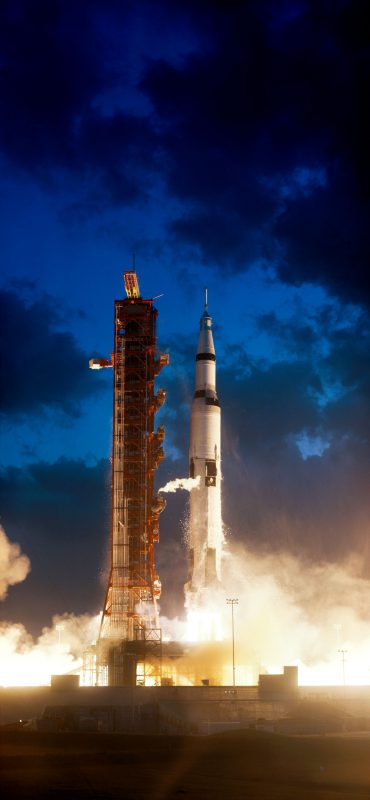
“…Nine, eight…Ignition Sequence Start…five, four, we have Ignition…”
All at once, a glowing orange mushroom cloud blossomed at the base of the Saturn V, rapidly spreading tendrils of flame in all directions across the marshy landscape. “We have liftoff…We have liftoff…7 a.m. Eastern Standard Time.”
Bleachers at the press site swayed, their light fixtures bounced and a flock of ducks changed course, without breaking their V formation. Astronaut Deke Slayton, who had come to Florida to watch, later recounted that he had “seen a lot of launches…but nothing was ever as impressive as that first Saturn V. It just rose, with naked power, lots of noise and light.” Fellow astronaut Tom Stafford—who would go on to ride one of these beasts on Apollo 10 in May 1969—remarked that Walter Cronkite’s CBS News trailer almost shook itself to pieces. “Suddenly,” wrote astronaut Mike Collins in his memoir, Carrying the Fire, “you realize the meaning of 7.5 million pounds of thrust. It can make the Cape Kennedy sand vibrate under your feet at a distance of four miles…”
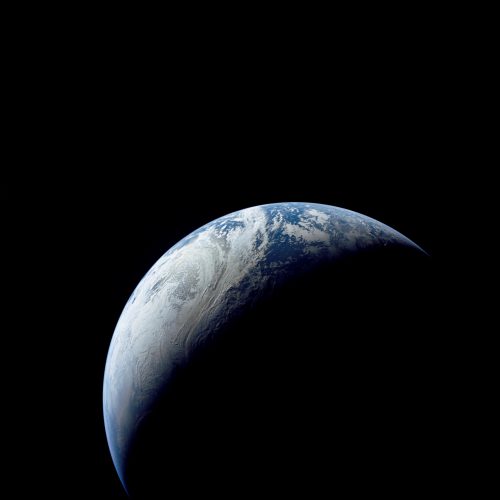
And yet perhaps the most memorable account was that of veteran CBS anchorman Walter Cronkite. “Our building’s shaking!” he exulted. “The roar is terrific. The building’s shaking. This big blast window is shaking. We’re holding it with our hands. Look at that rocket go into the clouds at 3,000 feet. The roar is terrific!”
The aim of the nine-hour mission was to evaluate the Apollo 4 spacecraft’s structural integrity, its compatibility with the Saturn V and its ability to enter a highly elliptical Earth orbit and perform a high-energy re-entry and splashdown in the Pacific Ocean. On its maiden flight, the Saturn V performed near-flawlessly, boosting Apollo 4 into a 115-mile-high (185 km) “parking orbit”, for two circuits of the Home Planet. The J-2 engine on the S-IVB third stage was then re-lit to lift the spacecraft’s apogee to over 10,560 miles (17,000 km). Apollo 4’s own Service Propulsion System (SPS) engine was fired to push outwards to over 11,000 miles (18,000 km), allowing for a 4.5-hour “soak” in the extreme radiation and temperature environment of deep space.
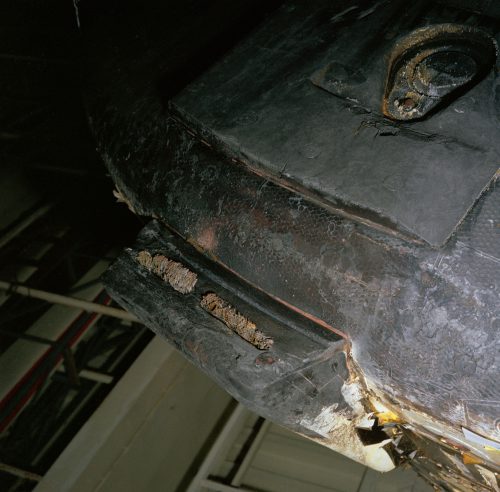
Finally, after three orbits and with the spacecraft’s nose pointed homeward, the SPS fired a second time to bring Apollo 4 back to Earth. The Service Module (SM) separated and the cone-shaped Command Module (CM) hit the upper atmosphere, just as it would at lunar-return velocity, peaking at 25,000 mph (40,000 km/h). Eight hours, 36 minutes and 59 seconds after leaving Pad 39A at Cape Kennedy, the CM splashed down in the Pacific, near Hawaii, and only ten miles (16 km) from the recovery ship, USS Bennington.
As well as marking the maiden flight of the Saturn V and the first use of Pad 39A—a launch complex which would go on to send the first human explorers to the Moon and support dozens of Space Shuttle missions—the Apollo 4 mission provided an enormous shot in the arm as America recovered from the tragic loss of Grissom, White and Chaffee. Over the following 5.5 years, the Saturn V would fly a further dozen missions, testing the Apollo spacecraft in low-Earth orbit and providing the muscle to send nine teams of lunar explorers to the Moon. Its swansong, in May 1973, configured uniquely as a two-stage vehicle, was to deliver America’s Skylab space station into orbit.
The Saturn V was an imperfect beast, of course, with a troubled development history. Its 13 missions during that half-decade span in the late 1960s and early 1970s did not run entirely to schedule. On the uncrewed Apollo 6 flight in April 1968, it suffered severe longitudinal “pogo” oscillations throughout its structure, whilst Apollo 12 was twice struck by lightning and Apollo 13 endured an engine-out situation during the initial boost to orbit. Yet never once did the Saturn V fail to deliver its precious human payload safely into space. And that, surely, is its lasting and most important legacy.




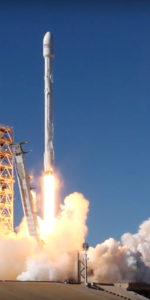
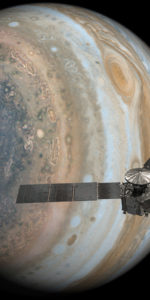
A magnificent vehicle. Neil Armstrong commented that the Saturn “gave us quite a ride” at the post-flight Apollo news conference. I also recall a model of the proposed “Nova” booster in an issue of National Geographic, circa 190-62.
As a teenager, the Saturn V launches and Apollo missions clearly demonstrated to me what amazing and wonderful things NASA and the rest of us Earthlings were capable of achieving.
The Saturn V launches and Apollo missions have withstood the test of time and continue to represent the excellence that we all should strive for.
I have that rocket and more. My Grandpa was Deputy Director at Marshall Space Flight and worked with Wernher Von Braun. wish I could attach a picture.